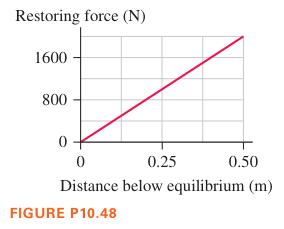When you stand on a trampoline, the surface depresses below equilibrium, and the surface pushes up on
Question:
When you stand on a trampoline, the surface depresses below equilibrium, and the surface pushes up on you, as the data for a real trampoline in Figure P10.48 show. The linear variation of the force as a function of distance means that we can model the restoring force as that of a spring. A 72 kg gymnast jumps on the trampoline. At the lowest point of his motion, he is 0.80 m below equilibrium. If we assume that all of the energy stored in the trampoline goes into his motion, how high above this lowest point will he rise?

Fantastic news! We've Found the answer you've been seeking!
Step by Step Answer:
Related Book For 

College Physics A Strategic Approach
ISBN: 9780134779218
4th Edition
Authors: Randall D. Knight, Brian Jones
Question Posted:





